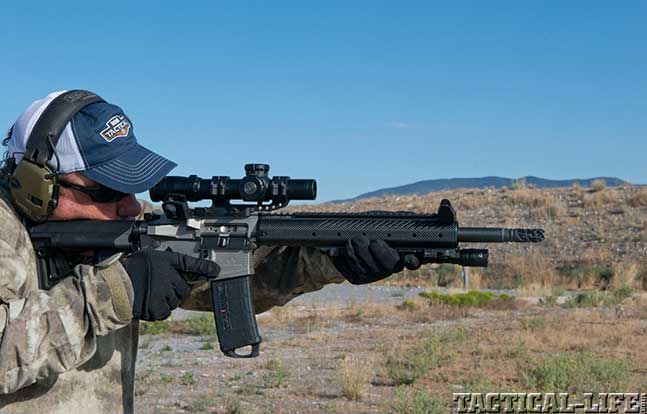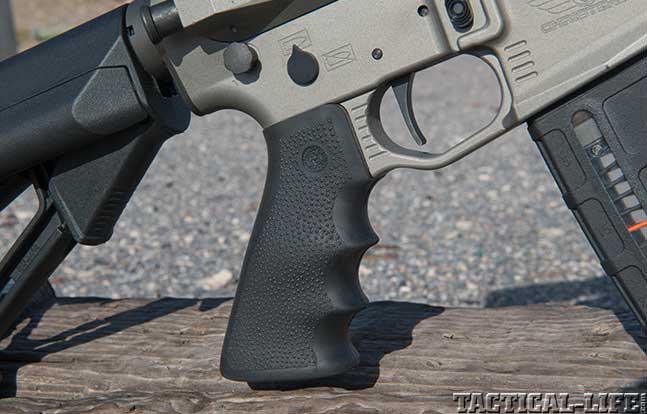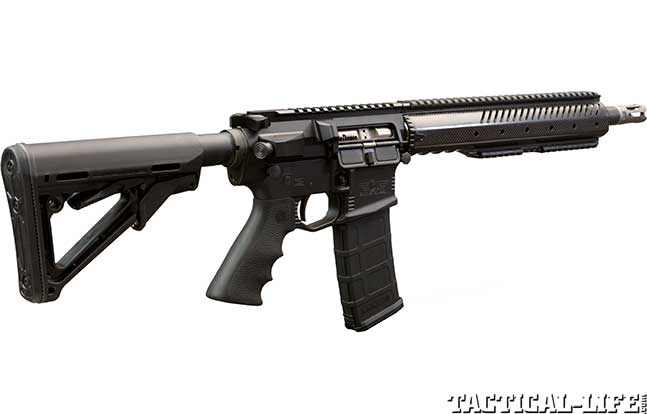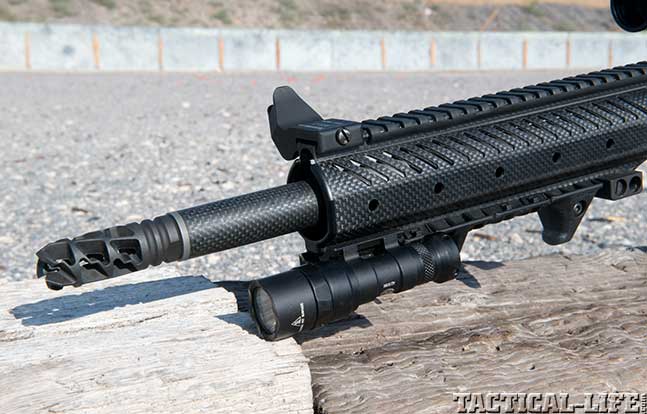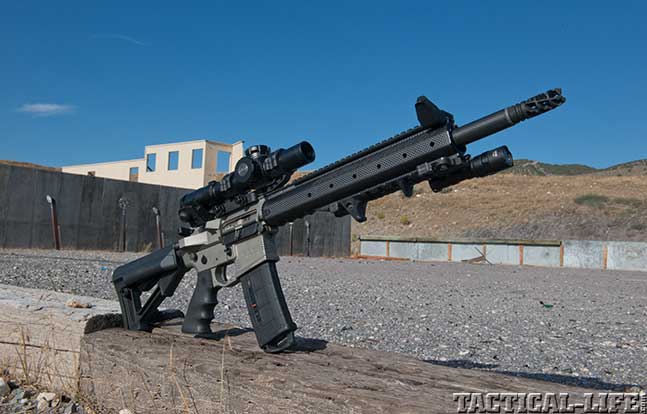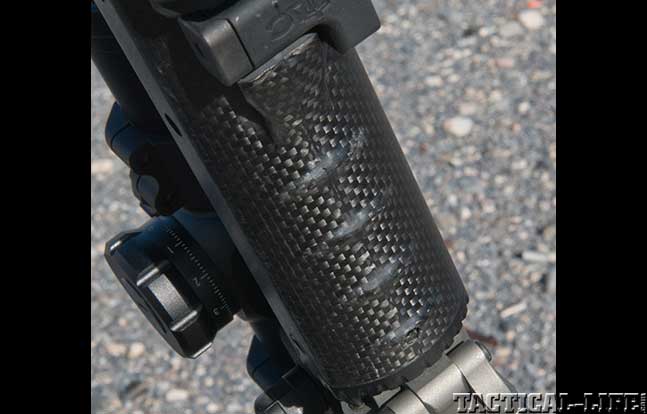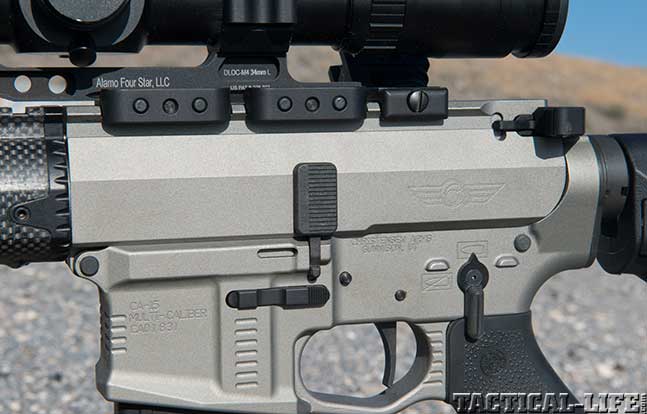The heart of Christensen Arms’ rifles, the barrels, are made by precisely blending steel and carbon fiber—a delicate construction process. While a few companies are trying to utilizes carbon fiber in this way, Christensen Arms brings a wealth of experience to the concept.
Saving Weight
Advertisement — Continue Reading Below
Most civilian and law enforcement users have come to appreciate light rifle systems, as they’re often carried more than fired, and excess weight generally means less comfort on long operations, hikes or hunts. Shedding weight is also a serious consideration for most military units. Along with a higher magazine capacity, one of the prime reasons the AR platform was adopted many years ago was because of its lighter weight. I personally have had to stand in place for hours on tactical operations, so having a lighter rifle without compromising accuracy or reliability is a huge plus, especially for your back and shoulders.
RELATED: Christensen Arms Introduces Tactical Force Multiplier Rifle
One of the simplest ways to reduce a rifle’s weight lies in altering the barrel. Shortening it can make a huge difference. Barrels can also be fluted or made thinner. But each can come at a cost. Short-barreled ARs are loud and can sometimes be unreliable; add a sound suppressor to the equation and it gets worse. Depending on how short the barrel is, ballistic efficiency can also be significantly compromised. Gas piston operating systems help in this regard, but they tend to be heavier. Installing a lighter barrel is another option, and mating carbon fiber to a steel barrel is currently the best way to get the job done. I recently got my hands on the Christensen Arms CA-15 Recon, a 5.56mm NATO AR-type rifle with a carbon-fiber-wrapped barrel and more weight-saving features.
Advertisement — Continue Reading Below
CA-15 Recon
The CA-15 Recon utilizes a 16-inch barrel and weighs 6.2 pounds unloaded. Typical mil-spec AR rifles with M4-profile barrels weigh closer to 7 pounds. Shedding a pound does not sound like much until you are on your 10th hour carrying the rifle. Considering the rifle’s upper and lower receivers are made from a billet of aluminum, this weight reduction is impressive.
Advertisement — Continue Reading Below
“Given the use of quality billet receivers, the overall weight of 6.2 pounds is impressive.”
As mentioned, most of the CA-15 Recon’s weight savings are found in the carbon-fiber-wrapped barrel. The barrel starts from a solid piece of steel. It is then bored, rifled, contoured and chambered in-house. Both the contour and wrapping process are well-guarded secrets, but it all happens there. The barrel is also given a match chamber and M4 feed ramps for enhanced accuracy and reliability. The barrel’s 1-in-9-inch twist rate is designed for stabilizing the heaviest 5.56mm bullets, and the muzzle features 1/2×28 threading for adding brakes, sound suppressors and other muzzle devices. My test rifle came with an OSS Banner flash suppressor in place.
Surrounding the barrel is a carbon-fiber handguard with a top Picatinny rail that matches the flattop upper’s, allowing users to mount night-vision gear or other accessories. The handguard’s short bottom rail accommodates bipods and other devices yet allows for a solid handhold at the rear. The sides of the forend are left smooth, but have been drilled and tapped for adding Picatinny rails as needed. The billet upper receiver houses a nitride-coated bolt carrier, an extended charging handle and a forward assist in a unique, angular housing.
Advertisement — Continue Reading Below
The billet-crafted lower receiver features an ambidextrous magazine release and an oversized bolt release. The extended triggerguard housing accommodates gloved hands. Christensen Arms’ LTM trigger is also installed. This system physically blocks the hammer when the “safe” setting is selected. Precision machined from the highest-quality materials, the trigger is smooth with a clean, creep-free break.
The lower receiver also features a Magpul STR buttstock and an Ergo rubber pistol grip with finger groves. Easy-access takedown pins are installed, meaning users can take the rifle apart without using tools. The upper and lower receivers have nicely matched contours, and each rifle is built by hand to your specifications; different triggers and other accessories can be added to your rifle upon request.
Advertisement — Continue Reading Below
Range Work
For sighting at the range, I installed a Bushnell 1-8.5x24mm Elite Tactical SMRS scope with a BTR-2 reticle. With the reticle mounted in the first focal plane, the scope is accurate at any power, and its locking target knobs provide plenty of elevation for most applications. Mounted in an Alamo Four Star mount, the scope returns to zero easily. I also mounted a set of Dueck Defense RTS backup sights, a SureFire Scout light, an Atlas bipod, a VTAC QD sling and a Magpul XTM hand stop.
Thought it’s set up as more of a patrol carbine, the CA-15 is built to be accurate enough to fill a designated marksman rifle (DMR) role. While visiting Christensen Arms’ facility, I was told the CA-15 Recon would shoot 0.5-inch groups without any issues. My best five-shot group at 100 yards, using Hornady 75-grain BTHP ammo, was very close. It measured 0.67 inches, with three of the five shots clustering into 0.25 inches. The rifle seemed to prefer the heavier rounds, as it was most accurate using match-grade bullets in the 75- to 77-grain range.
Advertisement — Continue Reading Below
At longer ranges, the CA-15’s accuracy was excellent. Shooting out to 300 yards, it was pretty easy to ring steel silhouettes. Even at 500 yards, the CA-15 managed eight hits out of 10 shots from prone using the BTR-2 reticle to holdover. There’s no reason to believe it will not hold at least 1 MOA out to the limits of the cartridge.
Because of its light weight, I expected more recoil than normal. But, if there was any increase in recoil, I didn’t notice it. Shooting from prone, the rifle barely moved. It even stayed in place nicely when I shot rapid-fire strings. The OSS Banner flash suppressor/brake works really well. With the Hornady TAP ammo, it was as efficient as three-pronged units, and better than a typical A2-style birdcage unit. It is a bit louder, however, from the shooter’s perspective than a pronged flash suppressor.
The LTM trigger was very crisp and clean. The design makes it easy to pull the trigger straight back for better precision. The safety is crisp, although an ambidextrous model would be a nice addition. The LTM system is proprietary, so if you want to change safeties you will need a different trigger.
Advertisement — Continue Reading Below
Cool Operator
Most of the criticism aimed at carbon-fiber-wrapped barrels revolves around the points of impact shifting when the barrel has heated up. Moving to 300 yards shortly after considerable rapid-fire shooting, the CA-15 did no worse than any other rifle. Shooting as fast as the target could be acquired, the rifle put 30 rounds into a 6-inch circle at 300 yards and 3 inches at 100 yards. Taking time to make each shot would result in tighter groups, but there was certainly no shift in impact due to heat.
Advertisement — Continue Reading Below
It took me a bit to get used to the feel of the carbon-fiber handguard. It’s certainly strong, but its light weight felt different. The heat dissipation was commensurate with most modern handguards, and my AR accessories were easy to mount.
This is certainly a nice rifle, and it really stands out when it comes to weight. Given the use of quality billet receivers, the overall weight of 6.2 pounds is impressive. You really notice it on the range—the carbine swings from target to target quickly and easily. It handles more like a short-barreled AR. The fit and finish were excellent, and the price is comparable to most custom-built ARs. If you are looking to move into the 21st century with your AR, Christensen Arms should be one of your first stops, and the CA-15 is an excellent choice.
For more information, visit christensenarms.com or call 888-517-8855.
